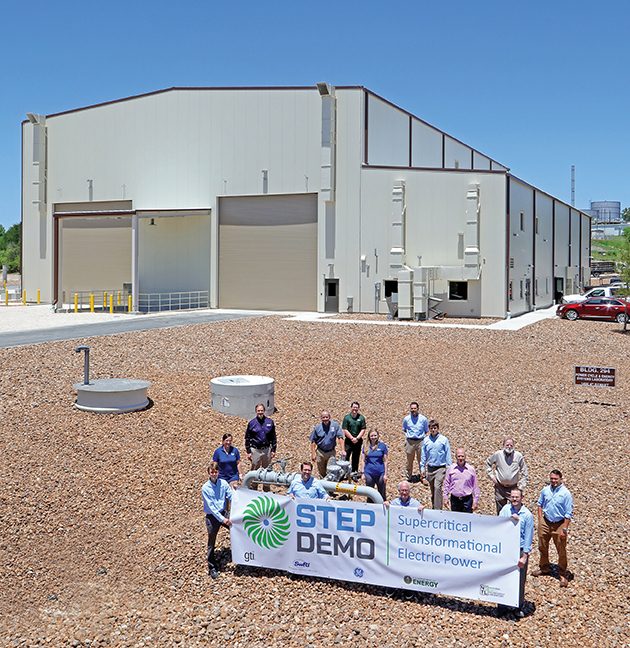
Construction has been completed on the building where breakthrough supercritical carbon dioxide (sCO2) technology for clean, compact, and high-efficiency power generation will be demonstrated. The transformational technology dramatically improves environmental performance, economics, and operational flexibility, and it is much more compact than conventional steam power cycle technology.
Located on Southwest Research Institute’s (SwRI’s) campus in San Antonio, TX, the 10-megawatt (MWe) pilot-scale plant will be among the largest facilities for sCO2 technology in the world.
With Department of Energy/National Energy Technology Laboratory (DOE/NETL) support, GTI is leading the Supercritical Transformational Electric Power (STEP) development team together with SwRI and GE Research (GE).
The aim of the STEP project is to advance high-temperature sCO2 cycle performance and promote the commercialization of more efficient and more flexible power plants. The team has designed the plant and finalized construction of the building that will be home to the facility. Equipment manufacturing and installation are progressing, followed by commissioning and start-up slated for early next year. After commissioning, comprehensive testing will mitigate risks in the advancement of sCO2 technology components and illustrate the operability and performance of this high-efficiency power cycle.
During the 22-month test phase, a versatile and reconfigurable fully-functional power plant employing sCO2 as the working fluid will be tested. Simple recuperated cycle testing will be performed first, followed by extended performance and long-term testing for the Recompression Closed Brayton Cycle (RCBC).
What is a supercritical carbon dioxide (sCO2) power cycle?
The sCO2 Brayton power cycle uses CO2 under high-pressure and high-temperature—supercritical—conditions as a working fluid instead of steam. The heated working fluid is circulated and compressed, which spins a generator to create electricity. The unique properties of sCO2 offer intrinsic benefits in closed cycles to absorb thermal energy, to be compressed, and to impart momentum to a turbine.
Using sCO2 as a working fluid for power cycles, instead of steam/water, offers the advantage of highly compact turbomachinery that will decrease capital costs, as well as reduce plant size and footprint. Its rapid response to load transients that can occur when integrated with wind or solar power generation positions sCO2 as a highly responsive and complementary technology for renewables. Advanced configurations can enable near-zero emission power generation, adding to its strong environmental performance.
In addition to using less fuel and consuming less water, sCO2 technology offers flexibility and versatility in many applications. It operates using a wide range of heat sources, including fossil fuel (natural gas and coal), renewables (concentrated solar, biomass, geothermal), next-generation nuclear, industrial waste heat recovery, and shipboard propulsion.
The STEP Project
The STEP project has the potential to revolutionize future power generation. The STEP facility is different from other sCO2-based power cycle project efforts due to its scale—it will be the only operating grid-connected power plant of this kind at a commercially relevant size.
Developing and maturing the technology at pilot scale will spur the development of necessary designs, materials, components, operation and control systems, sensors, and understanding and characterization needed for larger-scale sCO2 power conversion systems. Improvements in high-strength alloy materials and advancements in numerical modeling add value to the technology.
The project will advance the sCO2 Brayton power cycle and demonstrate performance over a range of operating conditions. The project will address a number of technical risks and challenges associated with key components of the technology, particularly materials and durability of equipment such as turbomachinery and recuperators. Information about system integration, operability, performance, and scale-up will move the technology toward commercialization.
Initially, the indirect sCO2 power cycle will be demonstrated to show the potential for achieving a lower cost of electricity and assess the ability to achieve thermodynamic cycle efficiency greater than 50% at commercial scales.
It will be followed by extended performance and long-term testing for a higher-temperature RCBC configuration that demonstrates system and component design and performance, including generating at least 10 MWe.
The effort is a significant step in moving the technology from the lab to the field. The STEP Pilot is being built as a multi-use facility to expand beyond current team members. After this program is complete, the reconfigurable facility could remain a testbed for future sCO2 technology advancements. Due to its flexible design, the STEP facility would be well-suited for many years as a proving ground that could offer technology developers and potential users access to commercial-scale testing for materials, components, and process technologies.
Worldwide Impact
With an increasing global demand for energy, electricity production is expected to grow faster than any other use of energy, employing diverse resources with regional variations. The next generation of transformational power processes will utilize technologies that enable clean, low-carbon power production that offers versatility, scalability, responsiveness, and lower costs.
In Europe and the U.S., electricity generated from gas is complementary to the increasing share of electricity generated from renewables, and will continue to play an important role in the transition to carbon neutrality.
International collaboration is critically important to successfully demonstrate new power cycle technology in projects that tend to be capital intensive. Numerous industry partners from around the world are supporting the STEP project, and discussions are continuing for others to join. ENGIE, a French multinational electric and gas company, recently joined American Electric Power (AEP), Korea Electric Power Company (KEPCO), Natural Resources Canada (NRCan), Southern Company, University of Houston, University of Wisconsin, and Texas Commission on Environmental Quality (TCEQ) to help guide the test activities and gain access to test data and intellectual property.
Original equipment manufacturers, engineering companies, and power plant owners/operators from around the world are invited to join this open Joint Industry Program to gain a better understanding of how transformational sCO2-based power cycles offer dramatically improved efficiencies, economics, and environmental performance.
The STEP project is bringing the transition to low-carbon, low-cost energy with a smaller footprint a step closer to fruition.














